The NVIDIA GeForce RTX 2060 6GB Founders Edition Review: Not Quite Mainstream
by Nate Oh on January 7, 2019 9:00 AM ESTPower, Temperature, and Noise
As always, we'll take a look at power, temperature, and noise of the RTX 2060 Founders Edition, though most of the highlights and trends we've seen twice before with the RTX 2080 Ti, RTX 2080, and RTX 2070 Founders Edition launches. For the most part, the dual axial fan open air design provide straightforward benefits in lower noise and cooling, which counterbalences the atypically large GPUs and new fixed-function hardware.
As this is a new GPU, we will quickly review the GeForce RTX 2060's stock voltages and clockspeeds as well.
| NVIDIA GeForce Video Card Voltages | ||
| Model | Boost | Idle |
| GeForce RTX 2060 (6GB) Founders Edition | 1.050V | 0.725V |
| GeForce RTX 2070 Founders Edition | 1.050v | 0.718v |
| GeForce GTX 1060 6GB Founders Edition | 1.062v | 0.625v |
The voltages are broadly comparable to the preceding 16nm GTX 1070. In comparison to pre-FinFET generations, these voltages are exceptionally lower because of the FinFET process used, something we went over in detail in our GTX 1080 and 1070 Founders Edition review. As we said then, the 16nm FinFET process requires said low voltages as opposed to previous planar nodes, so this can be limiting in scenarios where a lot of power and voltage are needed, i.e. high clockspeeds and overclocking. Of course, Turing (along with Volta, Xavier, and NVSwitch) are built on 12nm "FFN" rather than 16nm, but there is little detail on the exact process tweaks.
Power Consumption
The TDP increase to 160W brings the RTX 2060 (6GB) in between the 180W GTX 1080/1070 Ti and 150W GTX 1070. In turn, load consumption is more-or-less on that level, and nothing dissimilar to what we've seen. This also means that efficiency is around the same relative to performance, as opposed to the RTX 2070, 2080, and 2080 Ti.
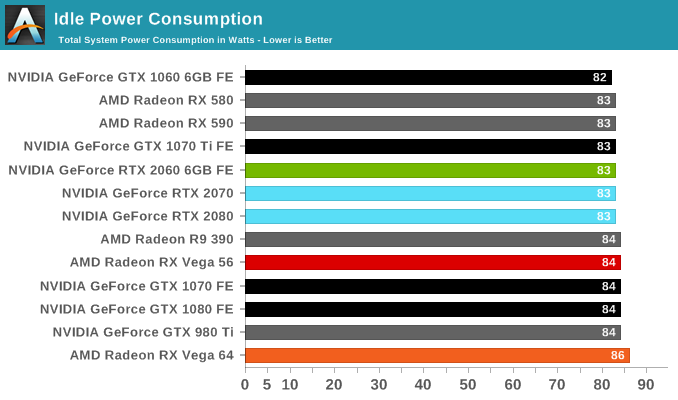
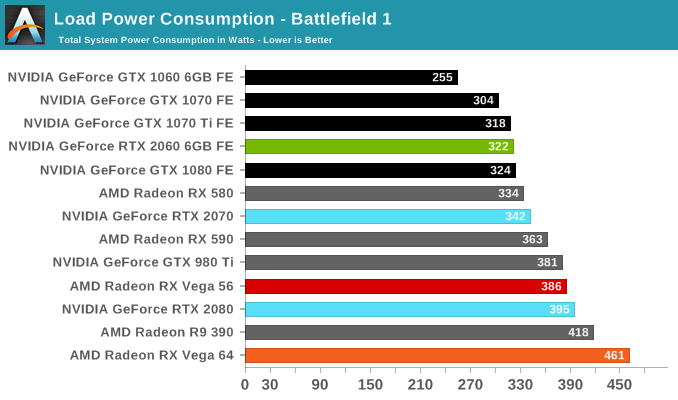
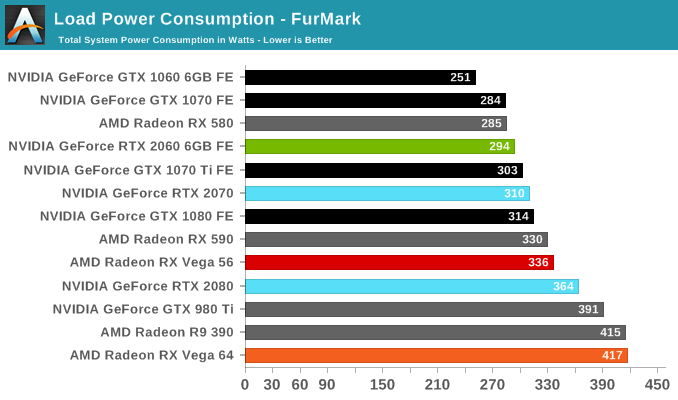
Temperature & Noise
With an open air cooler design with dual axial fans, the results are in line with what we've seen with the other RTX Founders Editions.
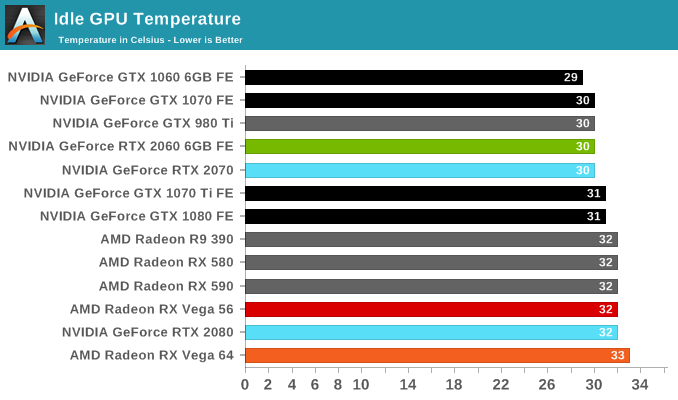
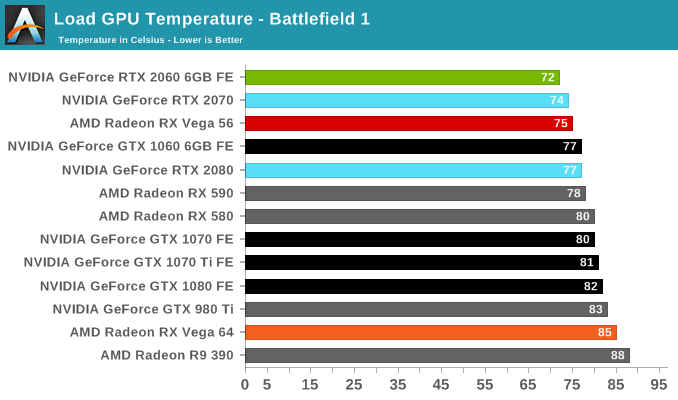
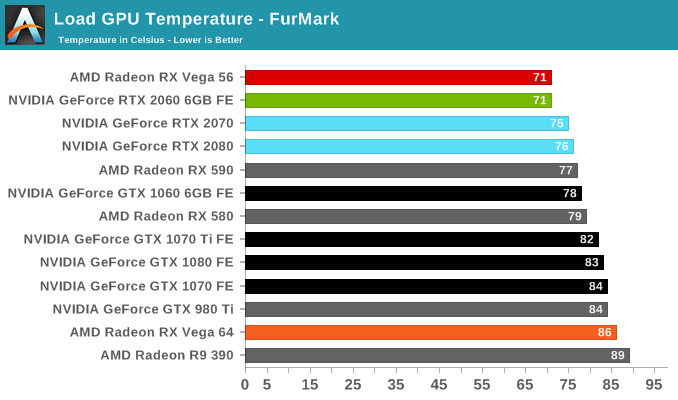

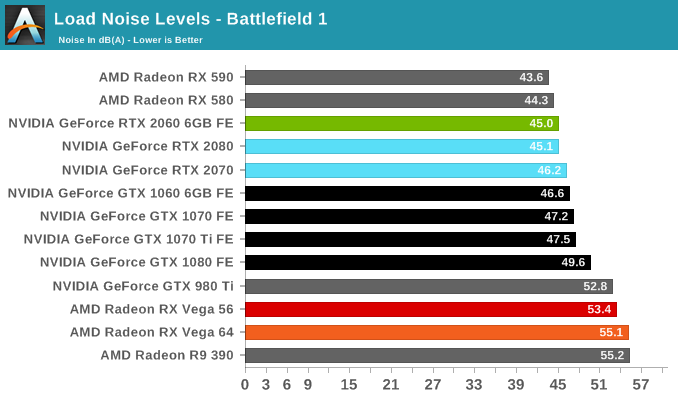
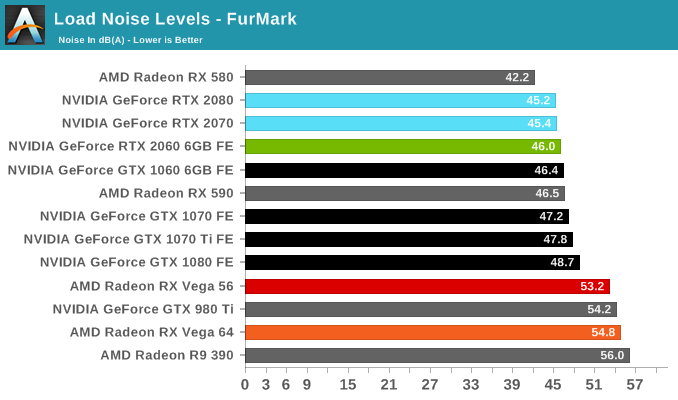










134 Comments
View All Comments
Retycint - Tuesday, January 8, 2019 - link
So you think its performance level is not worthy of its price tag? In that case then you wouldn't find a single GPU on the market right now that can meet your price/performance standardspiroroadkill - Tuesday, January 8, 2019 - link
So.. NVIDIA's back to their old ways of giving cards too little RAM. Their cards have typically had much less RAM than the ones from AMD. So the 2060 is a tiny bit faster than a 1070 Ti... But loses 2GB of VRAM. Once you start using over 6GB VRAM, the 2060 is going to lose hard to the 1070 Ti. Price is also too high. A firm "meh".mkaibear - Wednesday, January 9, 2019 - link
How about identifying a couple of games in which the 1070Ti "wins hard" over the 2060?I think you'll find that the 6Gb of RAM is more than enough to run games at the resolutions that the 1070Ti or 2060 excel at (1080p fast or 1440p 60Hz)
Disagree? provide me with some evidence!
prateekprakash - Tuesday, January 8, 2019 - link
Maybe AIB partners should offer one custom rtx 2060 with 12gb vram by using 2gb gddr6 chips, that may be helpful down the road...evernessince - Tuesday, January 8, 2019 - link
So who's going to bet this card doesn't launch at MSRP like every other Nvidia card this generation? You might as well throw away any price/performance comparison done in this article as well all know there is going to be Nvidia tax thrown on top of that price tag.If this is Nvidia's new mainstream card, I hate to see the price tag on their "budget" $200 2050.
catavalon21 - Thursday, March 7, 2019 - link
I am surprised that the answer to your question is "well, actually, many are" available at or about MSRP. The one thing I'm puzzle by, is even though the article states NVIDIA will sell their own cards (as they have and do for many other models), I haven't seen one listed on NVIDIA's site (other than linking to AIB cards) since day one.catavalon21 - Thursday, March 7, 2019 - link
*puzzled* - need more coffeeoverseer - Tuesday, January 8, 2019 - link
My sense tells me that RTX 2000 series will be a short-lived line, and NV shall come up with the next-gen (be it called 3000 series or not) on 7nm later this year. Why bother buying a half-node-like card now?sing_electric - Tuesday, January 8, 2019 - link
Well, people who are building now, for one. There's still a lot of people who were put off upgrades when mining shot prices through the roof; this is a new entry that's significantly faster than say, $200 cards.Having said that, I tend to agree with you: 7nm will probably offer significantly better performance, and if you care about raytracing, it's really the games that *started* development after the RTX came out that will show a real benefit (instead of seeing a reflection in one pond in one part of one map or something), and those games will be coming out around the time that the next-gen RTX will anyways.
richough3 - Tuesday, January 8, 2019 - link
The reality is that this card, spec wise is a replacement of the 1070, but to call it a 2070 would show small performance increases vs calling it 2060. With it being faster than a 1070 at $30 less MSRP, it's an okay upgrade from a 1060, although I would have rather had 8+ GB RAM. I would expect the 2050 TI to have similar specs as a 1060, although with just 4 GB RAM.